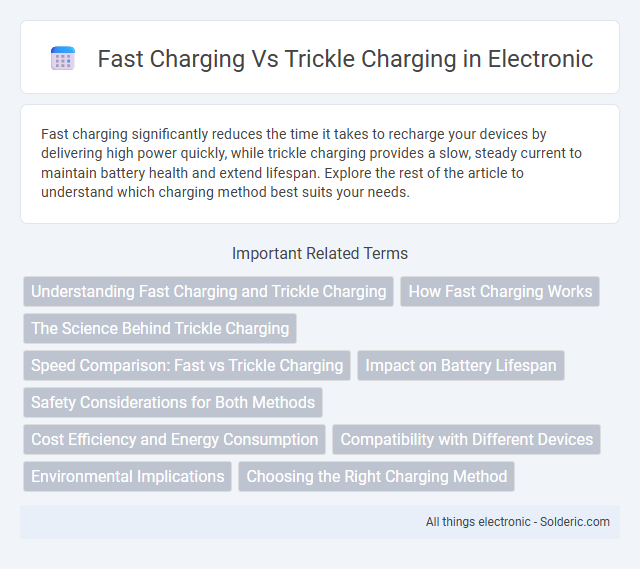Fast charging significantly reduces the time it takes to recharge your devices by delivering high power quickly, while trickle charging provides a slow, steady current to maintain battery health and extend lifespan. Explore the rest of the article to understand which charging method best suits your needs.
Comparison Table
| Criteria | Fast Charging | Trickle Charging |
|---|---|---|
| Charging Speed | High speed; charges batteries quickly within minutes to hours | Low speed; charges batteries slowly over extended periods (hours to days) |
| Current Level | High current output | Low current output |
| Battery Impact | Potential for increased heat and battery wear if overused | Extends battery life by maintaining full charge with minimal stress |
| Use Case | Quick recharge for immediate use | Maintaining charge over long periods; battery maintenance |
| Applications | Electric vehicles, smartphones, portable electronics | Backup power systems, lead-acid batteries, storage batteries |
| Energy Efficiency | Moderate; rapid energy transfer with possible losses | High; steady and controlled energy input |
| Cost | Typically higher due to advanced technology and infrastructure | Generally lower; simpler charging technology |
Understanding Fast Charging and Trickle Charging
Fast charging rapidly replenishes battery capacity by delivering higher power levels, significantly reducing charging time compared to traditional methods. Trickle charging maintains a low, steady current to keep a battery fully charged without overcharging, ideal for long-term battery maintenance. Understanding these charging methods helps optimize battery lifespan and performance based on usage needs and device specifications.
How Fast Charging Works
Fast charging works by delivering a higher voltage or current to your device's battery, significantly reducing the time it takes to reach a substantial charge level compared to trickle charging. This method relies on advanced battery management systems that regulate power flow to prevent overheating and battery damage, enabling rapid energy intake while maintaining safety. Understanding fast charging technology helps you optimize charging efficiency without compromising your device's lifespan.
The Science Behind Trickle Charging
Trickle charging uses a low, steady current to maintain a battery's full charge without overcharging, relying on precise voltage regulation and monitoring to keep the battery in a stable state. This method compensates for natural self-discharge by continuously restoring minimal energy, ensuring battery longevity by preventing heat buildup and electrode degradation. The controlled slow charge process promotes electrochemical balance within the battery cells, making trickle charging ideal for maintaining batteries in standby or infrequent use scenarios.
Speed Comparison: Fast vs Trickle Charging
Fast charging delivers high power output, significantly reducing your device's charging time by rapidly replenishing the battery in a fraction of the hours compared to trickle charging. In contrast, trickle charging provides a low, steady current intended to maintain battery capacity and prolong lifespan rather than quickly restore charge. Choosing fast charging is ideal when speed is essential, while trickle charging suits long-term battery health preservation.
Impact on Battery Lifespan
Fast charging significantly reduces charging time by delivering higher current, but it generates more heat, which can accelerate battery degradation and shorten overall lifespan. Trickle charging uses a low, steady current to maintain battery health, minimizing thermal stress and extending battery longevity by preventing overcharging and maintaining optimal charge levels. Battery management systems often balance these methods to optimize charging speed while preserving battery lifespan.
Safety Considerations for Both Methods
Fast charging generates higher heat and can stress battery cells, requiring advanced thermal management and safety circuits to prevent overheating or short-circuiting. Trickle charging delivers a low, steady current to maintain battery capacity without significant heat buildup, minimizing risks but potentially causing overcharging if not properly monitored. Both methods necessitate compatible chargers and protective features such as overvoltage, overcurrent, and temperature sensors to ensure battery longevity and user safety.
Cost Efficiency and Energy Consumption
Fast charging reduces overall energy consumption by minimizing charging time, which can lower electricity costs despite higher power demand during charging sessions. Trickle charging, while energy-efficient in maintaining battery charge, often results in prolonged electricity use and may increase overall cost due to longer charging durations. Your choice between fast and trickle charging should factor in the balance between immediate power draw and long-term operational expenses.
Compatibility with Different Devices
Fast charging technology is compatible with modern smartphones, tablets, and laptops supporting USB Power Delivery or Quick Charge protocols, delivering higher wattage for rapid replenishment. Trickle charging works universally with most rechargeable batteries, including older devices and gadgets without fast-charging circuits, ensuring safe and gradual power restoration. Device manufacturers often recommend trickle charging for prolonged battery health on devices lacking fast charge optimization.
Environmental Implications
Fast charging consumes more energy rapidly, potentially increasing carbon emissions depending on your power source, while trickle charging uses less power over a longer period, reducing environmental impact. The higher heat generated by fast charging can accelerate battery degradation, leading to more frequent replacements and increased electronic waste. Choosing trickle charging can promote battery longevity and reduce resource consumption, supporting more sustainable energy use.
Choosing the Right Charging Method
Fast charging delivers high current to rapidly restore battery power, ideal for time-sensitive use but may increase heat and reduce long-term battery lifespan. Trickle charging supplies a low, steady current that maintains full charge without overloading, preserving battery health during extended periods of inactivity. Selecting the right charging method depends on balancing quick energy replenishment needs against battery longevity and usage patterns.
Fast charging vs Trickle charging Infographic

 solderic.com
solderic.com